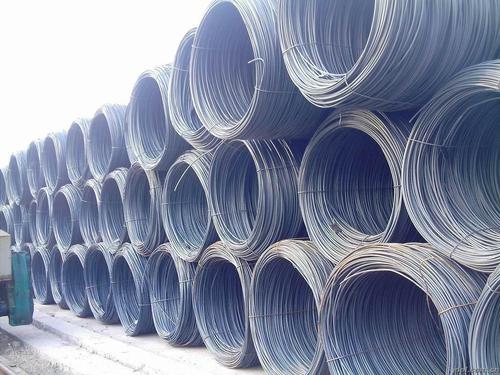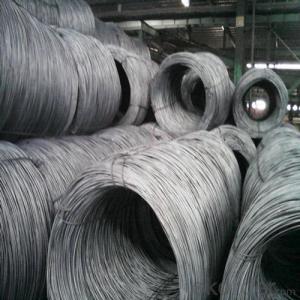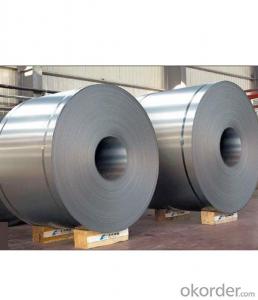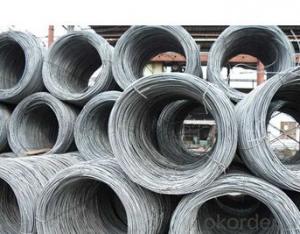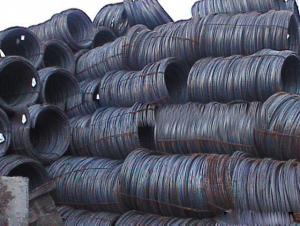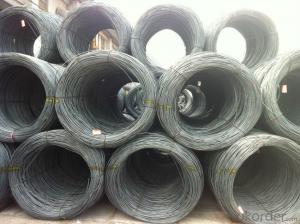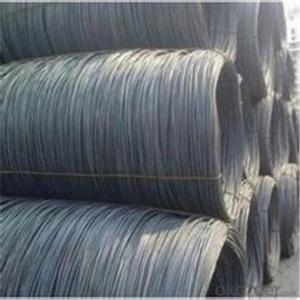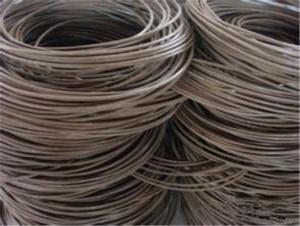Steel Wire Rod 6.5mm
- Loading Port:
- China Main Port
- Payment Terms:
- TT OR LC
- Min Order Qty:
- -
- Supply Capability:
- -
OKorder Service Pledge
OKorder Financial Service
You Might Also Like
Specifications of Steel Wire Rod in Coil:
Steel Grade: Q195/235, SAE1006-1018B Standard: ASTM, GB
Diameter: 6.5mm
Type: Drawn Wire Alloy or Not: Alloy Brand Name: HSKY
Technique: Hot Rolled Place of Origin: China Mainland
Chemical Composition:(Please kindly find our chemistry of our material based on SAE1006B and SAE1008B as below for your information)
Grade | Chemical Composition (%) | |||||
C | Mn | S | P | Si | B | |
SAE1006B | 0.03~O.07 | 0.32max | 0.045max | 0.040max | 0.30max | 0.0008min |
Mechanical properties | ||||||
Yield strength(N/mm2) | Tensile strength(N/mm2) | Elongation (%) | ||||
250-280 | 350-380 | ≥32 | ||||
Grade | Chemical Composition (%) | |||||
C | Mn | S | P | Si | B | |
SAE1008B | 0.10max | 0.3~0.50 | 0.050max | 0.040 max | 0.15max | 0.0008 min |
Mechanical properties | ||||||
Yield strength(N/mm2) | Tensile strength(N/mm2) | Elongation (%) | ||||
≥195 | 315-430 | ≥30 | ||||
- Q: How is steel wire rod used in the manufacturing of wire forms for medical devices?
- Steel wire rod is an indispensable element in the production of wire forms for medical devices. It acts as the raw material that is processed and converted into different wire forms used for medical purposes. To begin with, the steel wire rod undergoes a series of procedures such as drawing, annealing, and coating to enhance its properties and make it suitable for medical device applications. Drawing entails reducing the diameter of the wire rod through a sequence of dies, resulting in a thinner and more flexible wire. Annealing is a heat treatment process that improves the wire's ductility and eliminates any residual stresses. Coating, such as electroplating or passivation, is applied to the wire to provide corrosion resistance and enhance biocompatibility. Once the steel wire rod is processed, it can be utilized in the manufacturing of a wide range of wire forms for medical devices. These wire forms include springs, coils, guidewires, catheters, and various surgical instruments. Springs made from steel wire rod are utilized in devices like implantable cardiac pacemakers, where they offer mechanical support and aid in regulating the heart's rhythm. Coils and guidewires made from steel wire rod are used in minimally invasive procedures, such as stenting or catheterization, where they provide flexibility and maneuverability to navigate through blood vessels or other body structures. The high strength and durability of steel wire rod make it suitable for applications where reliability and precision are crucial, such as orthopedic implants or surgical instruments. It can be shaped into intricate forms and sizes, allowing for the production of customized wire forms that meet the specific requirements of different medical devices. Furthermore, steel wire rod's biocompatibility, when appropriately coated or treated, ensures that it does not have any adverse reactions with the human body, making it safe for use in medical applications. In conclusion, steel wire rod plays a vital role in the production of wire forms for medical devices. Through various processing techniques, it is transformed into springs, coils, guidewires, and other wire forms that provide mechanical support, flexibility, and precision in medical applications. The strength, durability, and biocompatibility of steel wire rod make it an excellent choice for the production of wire forms used in medical devices.
- Q: How is the steel wire rod market affected by changes in trade policies?
- Changes in trade policies can have a significant impact on the steel wire rod market. Trade policies, such as tariffs or import/export restrictions, can affect the supply and demand dynamics of steel wire rods. If a country imposes tariffs on imported steel wire rods, it can lead to a decrease in imports and an increase in domestic production. This can result in higher prices for steel wire rods within the domestic market. Conversely, if trade policies are liberalized, allowing for easier import and export of steel wire rods, it can increase competition and potentially lower prices. Therefore, changes in trade policies can influence the competitiveness and profitability of companies in the steel wire rod market.
- Q: How is steel wire rod used in the manufacturing of wire for musical instrument strings?
- Steel wire rod is an essential component in the manufacturing of wire for musical instrument strings. It serves as the raw material that undergoes a series of processes to transform it into the high-quality wire used in guitar, piano, violin, and other instrument strings. To begin with, steel wire rod is typically made from carbon steel, which is known for its strength and durability. This makes it an ideal material for producing wire that can withstand the tension and stress exerted on musical instrument strings during playing. The manufacturing process starts with the steel wire rod being heated and then rolled into thinner strands through a process called drawing. This drawing process helps to refine the steel wire rod by elongating and thinning it, resulting in a more uniform and consistent diameter. Once the wire has been drawn to the desired thickness, it undergoes a series of heat treatments to improve its mechanical properties. This includes processes such as annealing, which helps to relieve stress and enhance the wire's flexibility and elasticity. After the heat treatments, the steel wire is further processed to achieve the desired characteristics for musical instrument strings. This can involve additional drawing steps to achieve the desired gauge or diameter, as different instruments require specific string thicknesses for optimal sound production. Furthermore, the wire can be coated with various materials to enhance its performance and longevity. For instance, a thin layer of nickel or stainless steel may be applied to improve corrosion resistance and provide a smoother surface for playing. Finally, the wire is wound onto spools, ready to be used by manufacturers of musical instrument strings. These strings are then carefully crafted and assembled, incorporating the steel wire as the core material that carries the tension and produces the desired pitch and tone when played. In summary, steel wire rod is a critical material used in the manufacturing of wire for musical instrument strings. Through various processes such as drawing, heat treatments, and coating, the steel wire rod is transformed into high-quality wire that meets the specific requirements of different instruments. The resulting strings provide musicians with the necessary strength, flexibility, and tonal characteristics to create beautiful music.
- Q: What is the average price of steel wire rod?
- Several factors, such as market demand, production costs, and global economic conditions, can cause fluctuations in the average price of steel wire rod. Currently, in [current year], the price range for steel wire rod per metric ton falls between [price range]. Nevertheless, it is crucial to acknowledge that prices can experience substantial fluctuations over time. Therefore, it is advisable to consult industry experts or suppliers for the most reliable and recent pricing information.
- Q: How is steel wire rod used in the manufacturing of wire forms for industrial filters?
- The manufacturing process of wire forms for industrial filters heavily relies on steel wire rod. This crucial component undergoes a series of mechanical and chemical processes to ensure its durability and strength. Once it meets the required specifications, it is then transformed into various wire forms used in constructing industrial filters. One of the key purposes of steel wire rod in manufacturing wire forms for industrial filters is to establish the support structure. Typically, the wire rod is bent, twisted, or welded to create a robust framework that holds the filter together. This support structure guarantees that the filter can withstand the pressure and stress it will encounter during operation. Moreover, steel wire rod is utilized to fabricate the filtering elements within industrial filters. These filtering elements are often crafted by weaving, knitting, or welding the wire rod into a mesh or screen-like structure. This enables the filter to effectively capture and remove unwanted particles or contaminants from different fluids or gases. The strength and durability of steel wire rod make it an ideal material for manufacturing wire forms for industrial filters. It can endure high temperatures, corrosive environments, and heavy loads, ensuring the filter remains functional and reliable even in challenging industrial settings. Additionally, steel wire rod can be easily manipulated and customized to meet specific requirements. By selecting the appropriate steel grade and applying specific manufacturing techniques, manufacturers can achieve different diameters, tensile strengths, and surface finishes. This versatility enables the creation of wire forms tailored to the specific needs of various industrial applications. In conclusion, steel wire rod plays a vital role in the manufacturing of wire forms for industrial filters. Its strength, durability, and versatility are essential for creating support structures and filtering elements that are necessary for the proper functioning of these filters.
- Q: What are the common traceability requirements for steel wire rod?
- Some common traceability requirements for steel wire rod include the need to track and document the origin of the raw materials used in production, maintain records of the manufacturing process, and provide clear identification and labeling of each batch or lot of wire rod. Additionally, traceability often involves the ability to trace the product back to its manufacturer and provide information on quality control measures and inspection results throughout the supply chain.
- Q: What are the main factors influencing the choice of steel wire rod order replacement policy?
- The main factors influencing the choice of steel wire rod order replacement policy include the current inventory levels, demand forecasting accuracy, lead time for procurement, production capacity, and customer requirements. Additionally, factors such as cost considerations, market conditions, and supplier reliability also play a significant role in determining the replacement policy for steel wire rod orders.
- Q: What are the different types of steel wire rod drawing dies?
- There exist various types of steel wire rod drawing dies, each specifically designed for certain applications and materials. 1. Single crystal diamond dies: These dies are crafted from a solitary crystal diamond and are renowned for their exceptional durability and resistance to wear. They are commonly utilized for drawing high carbon steel wires and other hard substances. 2. Polycrystalline diamond (PCD) dies: PCD dies are constructed from multiple small diamond grains that have been bonded together. They offer commendable wear resistance and are suitable for drawing medium to high carbon steel wires, stainless steel wires, and non-ferrous materials. 3. Tungsten carbide dies: These dies are manufactured by combining tungsten and carbon, resulting in an exceedingly hard and wear-resistant material. They are frequently employed for drawing low to medium carbon steel wires and non-ferrous wires. 4. Natural diamond dies: These dies are created from natural diamonds, which provide exceptional wear resistance and a smooth surface finish. They are commonly utilized for drawing fine and ultra-fine wires, such as those found in the electronics industry. 5. PCD-coated dies: These dies possess a layer of polycrystalline diamond coating applied to a substrate made of tungsten carbide or steel. They combine the wear resistance of PCD with the toughness of the substrate material, making them suitable for drawing a wide range of materials, including steel, stainless steel, and non-ferrous alloys. 6. Ceramic dies: Ceramic dies are crafted from materials such as tungsten carbide, alumina, or zirconia. They offer commendable wear resistance and can be used for drawing steel wires, stainless steel wires, and non-ferrous materials. In conclusion, the selection of a steel wire rod drawing die relies on the specific application, wire material, and desired quality of the end product. It is crucial to choose the appropriate type of die to ensure optimal performance and longevity.
- Q: What are the different types of steel wire rod rolling processes?
- There are several different types of steel wire rod rolling processes, each with its own unique characteristics and advantages. Some of the most commonly used processes include: 1. Hot rolling: This is the most common method used to produce steel wire rods. In this process, the steel is heated above its recrystallization temperature and passed through a series of rolling mills to reduce its thickness and increase its length. Hot rolling results in a finer grain structure, improved mechanical properties, and a higher surface quality. 2. Cold rolling: This process involves passing the steel wire rod through a series of rolling mills at room temperature or below its recrystallization temperature. Cold rolling is typically used to produce smaller diameter wire rods with tighter tolerances and improved surface finish. It also provides higher strength and hardness compared to hot rolling. 3. Thermomechanical rolling: This process combines elements of both hot and cold rolling. The steel wire rod is heated to a temperature slightly above its recrystallization temperature and then rolled at a lower temperature. This allows for better control over the mechanical properties and microstructure of the wire rod, resulting in enhanced strength and toughness. 4. Controlled cooling rolling: In this process, the steel wire rod is cooled at a controlled rate after hot rolling. This controlled cooling helps to refine the microstructure and enhance the mechanical properties of the wire rod. It is commonly used to produce high-strength wire rods for applications requiring excellent fatigue resistance and durability. 5. Micro-alloyed rolling: This process involves adding small amounts of alloying elements, such as vanadium or niobium, to the steel wire rod before rolling. These alloying elements help to refine the grain structure and improve the mechanical properties of the wire rod, such as strength and toughness. Micro-alloyed rolling is often used to produce wire rods for high-stress applications, such as automotive and construction industries. Overall, the choice of steel wire rod rolling process depends on the desired properties and specifications of the end product. Each process offers distinct advantages and can be tailored to meet specific industry requirements.
- Q: How does the quality of steel wire rod affect the performance of wire products?
- The performance of wire products is heavily influenced by the quality of the steel wire rod. The strength and durability of wire products directly depend on the quality of the steel wire rod. When high-quality steel wire rods are used, they are made from superior materials and undergo strict manufacturing processes. As a result, they have enhanced tensile strength and resistance to deformation. This ensures that wire products can bear heavy loads, tension, and stress without breaking or losing shape. On the other hand, low-quality steel wire rods are more prone to breakage, stretching, or bending under similar conditions. This compromises the performance of the wire products and can potentially lead to hazardous situations. The overall performance of wire products is also affected by the surface finish of the wire rod. Precise manufacturing techniques are used to achieve a smooth and uniform surface finish, which reduces friction and abrasion during the use of wire products. This not only extends their lifespan but also improves their functionality. In contrast, wire rods with poor surface finish may have rough or uneven surfaces, resulting in increased friction and wear. This can lead to premature degradation, decreased performance, and potential safety hazards. Additionally, the chemical composition of the steel wire rod has an impact on the corrosion resistance of wire products. High-quality wire rods are typically made from corrosion-resistant materials or have protective coatings, which prevent rust or corrosion over time. This is particularly important for wire products used in outdoor or moist environments where exposure to water, humidity, or chemicals may occur. Wire products made from low-quality wire rods with inadequate corrosion resistance can deteriorate faster, leading to decreased performance, structural weakness, and potential failure. To summarize, the quality of the steel wire rod directly affects the performance of wire products. Opting for higher quality wire rods ensures the production of stronger, more durable, and longer-lasting wire products. These products have enhanced resistance to deformation, improved surface finish, and better corrosion resistance. Investing in high-quality steel wire rods guarantees the production of wire products that meet performance standards, provide reliable functionality, and ensure user safety.
Send your message to us
Steel Wire Rod 6.5mm
- Loading Port:
- China Main Port
- Payment Terms:
- TT OR LC
- Min Order Qty:
- -
- Supply Capability:
- -
OKorder Service Pledge
OKorder Financial Service
Similar products
Hot products
Hot Searches
Related keywords

